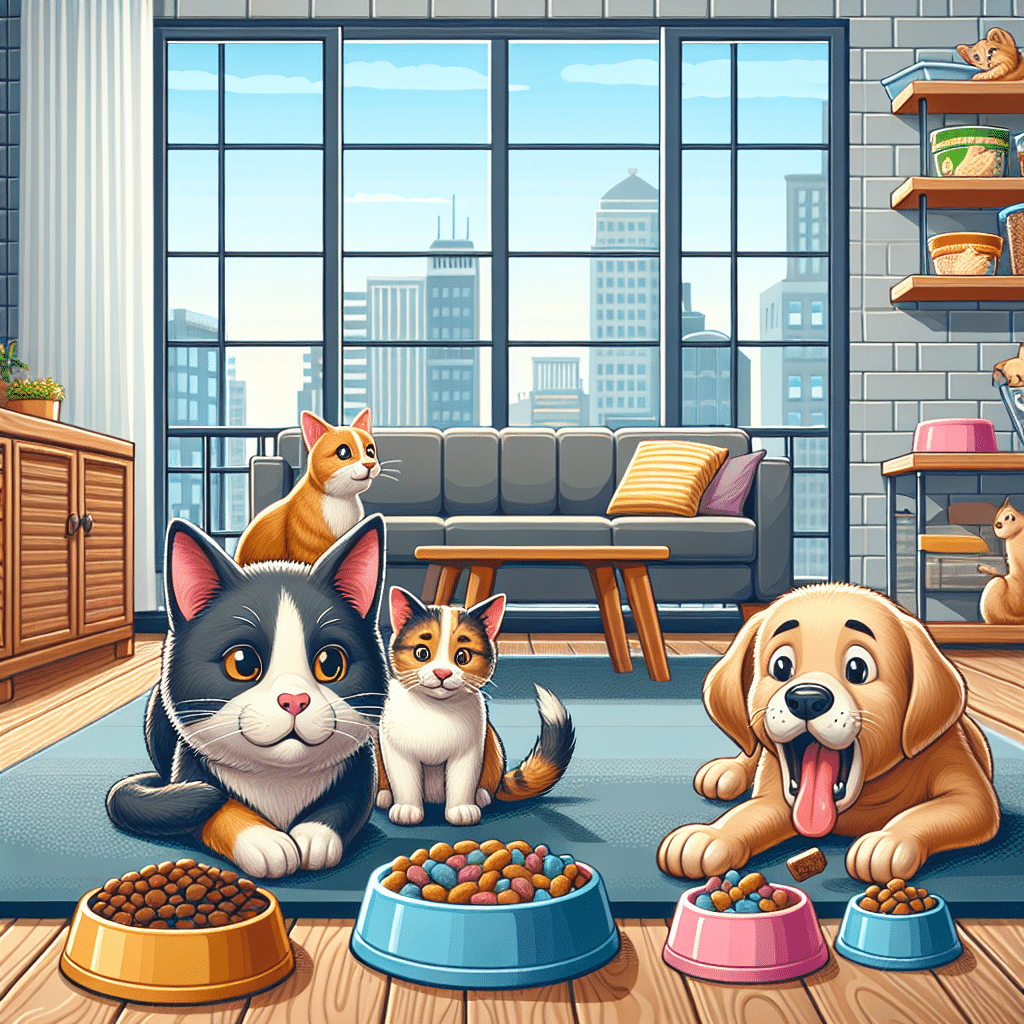Healthy Pet Diets for Apartment Living: A Comprehensive Guide
Understanding Nutritional Needs
When living in an apartment, pet owners must prioritize their furry companions’ nutritional needs. The first step in creating a healthy diet is understanding the specific dietary requirements of each pet species and breed.
-
Cats:
- Protein-Rich Diet: Cats are obligate carnivores and require high-quality protein sources. Look for cat foods where meat or meat meal is the first ingredient.
- Taurine: This essential amino acid is critical for heart, eye, and reproductive health.
- Low Carbohydrate Content: Since cats do not need carbohydrates, choose foods with minimal fillers like corn and wheat.
-
Dogs:
- Balanced Optimal Diet: Ensure dog food contains a balance of protein, fats, carbohydrates, vitamins, and minerals. Ingredients should include whole meats, vegetables, and grains.
- Age-Specific Needs: Puppies, adult dogs, and senior dogs have different nutritional needs, so tailor diets accordingly.
-
Small Pets:
- Rabbits and Guinea Pigs: Fresh hay should comprise the majority of their diet, with fresh vegetables as an occasional treat.
- Hamsters and Gerbils: High-quality pellets that include seeds, grains, and the occasional fresh vegetable are essential.
Choosing the Right Food
Quality Over Quantity
Prioritize premium brands with clear labeling. Look for:
- AAFCO Statement: Foods meeting the standards set by the Association of American Feed Control Officials ensure proper nutrient levels.
- Limited Ingredients: For pets with allergies, consider limited ingredient diets that focus on a single protein and fewer fillers.
Wet vs. Dry Food
- Dry Food: More convenient and often less expensive. It’s ideal for dental health as it helps reduce plaque. However, ensure it is high in animal protein.
- Wet Food: Contains higher moisture content which can be beneficial for hydration, particularly in cats. It’s also palatable for picky eaters but may be more costly.
Special Dietary Considerations
-
Weight Management: In apartments, pets may have limited space to exercise, leading to weight gain.
- Choose low-calorie food options and monitor portion sizes.
- Incorporate healthy treats such as carrot sticks or apple slices.
-
Hydration: Adequate water intake is essential. In small living spaces, consider:
- Providing a pet fountain, as many animals prefer running water.
- Ensuring fresh water is available at all times.
-
Allergies and Sensitivities: Common allergens include grains and certain proteins.
- Consult with a veterinarian for hypoallergenic food options if your pet shows signs of allergies (e.g., itching, gastrointestinal issues).
Homemade Diets: Pros and Cons
Homemade diets can be tailored to an individual pet’s needs, but they must be carefully formulated to avoid nutritional deficiencies.
Advantages:
- Control Over Ingredients: Ensures no fillers or harmful additives.
- Customization for Allergies: Easily target specific proteins or vegetables that suit your pet’s needs.
Disadvantages:
- Time-Consuming: Preparing balanced meals can take time and require knowledge of nutritional requirements.
- Risk of Imbalance: Mistakes in formulation can lead to health issues.
Strategizing Feeding Schedules
Establish a schedule to promote routine and a healthy appetite.
- Consistency is Key: Feed pets at the same time each day to aid digestion and avoid begging behaviors.
- Portion Control: Follow the feeding guidelines on the pet food package based on weight and activity levels.
Incorporating Supplements
Consider adding supplements to bolster your pet’s diet when necessary. Consult with a veterinarian to determine the appropriate supplements:
- Probiotics: Good for digestive health and can help manage sensitive stomachs.
- Omega Fatty Acids: Beneficial for skin and coat health, especially in dry environments.
Engaging Pets in Food Preparation and Feeding
Make mealtime more engaging to prevent boredom and keep pets mentally stimulated.
- Puzzle Feeders: Encourage problem-solving while eating, which can slow down fast eaters and promote mental stimulation.
- Hide-and-Seek Treats: Place healthy treats around the apartment to encourage exploration and activity.
Essential Guidelines for Treats
Treats should not exceed more than 10% of your pet’s daily caloric intake. Opt for healthy, low-calorie options:
- Vegetables: Carrots, peas, and green beans can be great snacks for dogs.
- Commercial Treats: Look for those made from whole ingredients and without artificial additives.
Behavior and Diet Interconnection
Diet can significantly impact behavioral issues. A balanced diet can prevent problems like anxiety and aggression. Monitor your pet’s behavior closely after dietary adjustments.
Adapting to Apartment Lifestyle
Consider your apartment’s space to ensure your pet’s eating area is conducive to healthy eating habits:
- Designated Eating Space: Create a clean, quiet area for meals that minimizes distractions.
- Stable Feeding Stations: Elevated food and water bowls can help, especially for larger breeds.
Importance of Regular Veterinary Checkups
Routine veterinary visits are crucial for monitoring your pet’s weight and overall health, making dietary adjustments as necessary. Ensure vaccinations, dental health, and conditions like obesity are regularly reviewed to extend your pet’s life.
Conclusion
Prioritizing quality nutrition is vital for pets, especially in the limited space of an apartment. By choosing the right type of food, managing portion sizes, and ensuring adequate exercise and mental stimulation, pet owners can foster healthier and happier lives for their companions. Adapting diets according to individual needs and consulting professionals when necessary will benefit both pets and their owners living in urban settings.
